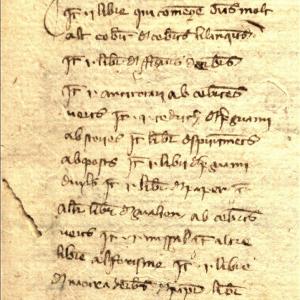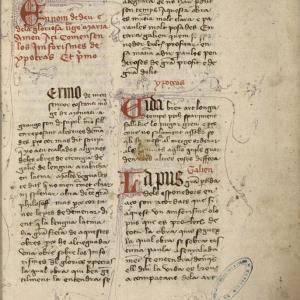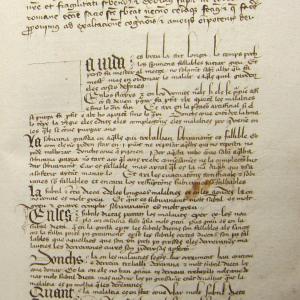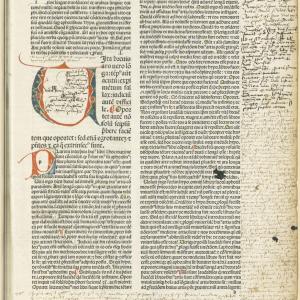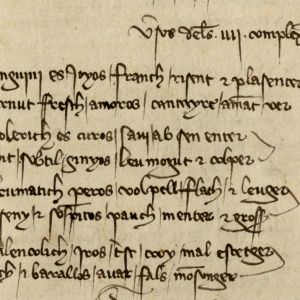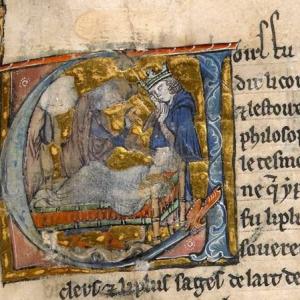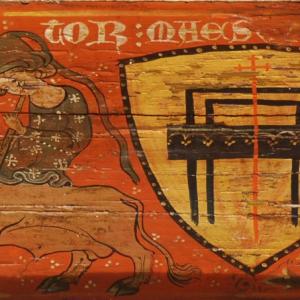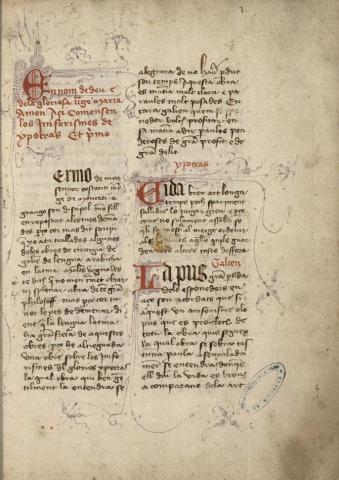
The medieval Catalan translations of Hippocrates’ 'Aphorisms'
The Aphorisms, written between the late fifth century and the middle of the fourth century BC, are the most famous text of the Corpus Hippocraticum, the series of treatises written in Ionic dialect that have been attributed to Hippocrates of Kos (fig. 1) and his collaborators. Hippocrates himself seems to have been the author of the Aphorisms, which he must have written as an old man. Divided into seven sections or “particles”, they are a series of brief juxtaposed propositions that were conceived as a method of stimulating doctors’ memories, rather than as a summary of all the knowledge that a medical practitioner ought to have.
Testimony to the success of the Aphorisms throughout history are the commentary written by Galen (c. 130-200), the one by Oribasius of Pergamon (c. 325-400), the 150 surviving Greek manuscripts (fig. 2), the 70 or so Arabic manuscripts (fig. 3), the more than 200 Latin manuscripts (figs. 7-8) and the medieval commentaries by famous doctors like Peter of Spain, Burgundio of Pisa, Taddeo Alderotti, Ugo Benzi, and others.
The Aphorisms played a leading role in the teaching of medicine in the Middle Ages, as they were among the textbooks used by universities (fig. 6). They occupied an important place in the Articella, the group of medical texts that emerged in the twelfth century from the Salernitan school of medicine that gradually spread to all medieval faculties of medicine: Paris, Naples, Padua, Bologna and Montpellier, to mention only the most distinguished. The best-known version of the Aphorisms, with Galen’s commentary included, is the Latin translation made of it by Constantine the African in the eleventh century (figs. 4-7).
Evidence of the great dissemination of the Aphorisms all over Latin Western Europe – and proof that basic medical knowledge interested different areas of society – is their presence in literature (fig. 14). Dante mentions them in the Commedia as a synonym for practical and theoretical medicine (Chi dietro a iura e chi ad Amforismi…, ‘Some follow law, some the Aphorisms…’ Paradiso, XI.4) and Ausiàs March copies the first aphorism of the treatise in the initial verses of poem 113:
La vida·s breu e l'art se mostra longa;
l'esperiment defall en tota cosa;
l'enteniment, en lo món no reposa;
al juhí d'hom la veritat s'allonga.
[Life is short and art is shown to be long, | experimentation dies in everything | understanding, in the world does not rest; | the truth is far from man’s judgment.]
These explicit allusions to the Aphorisms are complemented by the very well known presence of the figure of Hippocrates in all kinds of written works and in the fine arts (fig. 5), as one of the universally best-known medical authorities and as the father of medicine.
Leaving to one side the above-mentioned Latin and Arabic ones, medieval translations exist of Hippocrates’ Aphorisms into at least three more languages, Hebrew, French and Catalan, the majority of which include Galen’s commentary. The most outstanding Hebrew translation, from Arabic, was by Nathan ha-Meati, who translated Avicenna’s Canon in Rome in 1283, also from Arabic into Hebrew. This translation includes Galen’s commentary, but there are other anonymous Hebrew translations that do not include it. The French translation, from Latin and with Galen’s commentary, was made between 1362 and 1363 by Martin de Saint-Gille, the doctor of Joanna of Bourbon, wife of the future King Charles V of France, who was a great bibliophile and a promoter of translations into French. Martin de Saint-Gille, however, did rather more than translate, as he added personal comments to the text.
There are two different Catalan translations of Hippocrates’ Aphorisms, which show us the vitality of the process of vernacularization of medicine in this language. One (translation A) is conserved in manuscript 568 in the Bibliothèque municipale in Bordeaux. It contains Galen’s commentary and is based on Constantine’s version (fig. 11). The other (translation B) is a version that has survived in a very fragmentary state and lacks Galen’s commentary. It is conserved in manuscript 96-31 in the Biblioteca Capitular in Toledo (fig. 10). Both are prior to 1320/1330, but it is not possible to date them precisely. More details will be given below.
The Aphorisms appear profusely recorded in the medieval libraries of the Catalan Countries, in both those that belonged to medical practitioners and in those that did not, something that clearly shows the broad social diffusion of medical knowledge. Thus, through a document of 1381 we know that King Peter III had the Aphorisms with Galen’s commentary, almost certainly in Latin, a work that also figured in the library of King Alfonso the Magnanimous. The Aphorisms are recorded in cathedral libraries and in the papal one at Peníscola. They also interested members of the urban bourgeoisie, such as Berenguer Rubió, a citizen of Valencia (1347), or Joan Deslledó, a merchant of Majorca (1435), who both had copies of it that do not indicate in which language they were written. With regard to medical practitioners, they appear in the library of Arnald of Villanova, in that of James II’s surgeon Bernat Serra, and in those of several doctors, surgeons and apothecaries from Valencia, Majorca and Catalonia in the fourteenth, fifteenth and sixteenth centuries.
Some of these recorded copies must have been in Catalan, but the writers of the inventories did not deem it necessary to mention this. We find the first title written in Catalan in the library of the surgeon from Santa Coloma de Queralt Pere Ritxard (fig. 9), inventoried in 1363 (“Alforisme”), but we cannot be sure if it was written in this language. The one owned by Antoni Molera, a surgeon from Vic, definitely was, as it states in the inventory of his goods in 1505: un libre appellat Anforismes d’Ipocràs, en pla i en latí, de mà ab sa cuberta (‘a book entitled Aphorisms by Hippocrates, in the vulgar and in Latin, handwritten, with its cover’).
Catalan translation A is conserved in MS 568 in the Bibliothèque municipale in Bordeaux (fig. 10). Written in Gothic cursive script by a single hand, with the capital letters filigreed in two colours and the headings in red, this manuscript contains a rather luxurious copy of the Catalan translation of the Aphorisms, although it has no illustrations and is not written on parchment. The script and the filigrees of the paper date the codex to the first half of the fifteenth century. This copy contains the seven sections of the Aphorisms and it may be incomplete since although the explicit appears after the last aphorism there is no corresponding commentary by Galen.
The translation has the usual characteristics of this type of text, so it is a perfect example of the process of translating medical and scientific texts that took place in the Crown of Aragon from the end of the thirteenth century onwards, coinciding with the reign of James II. In general, the text is quite faithful to the Latin original. This means that it does not contain glosses, that it sometimes shortens the Latin version, that it keeps Latin and learned words, often accompanied by a brief explanation introduced with the formula ço és… (‘that is…’), or that it translates a Latin word by using two Catalan synonyms.
This translation of the Aphorisms cannot however be described as excellent. Occasionally, it wrongly interprets the meaning of a sentence, so the text is hard to understand. It also reads a Latin word wrongly and thus introduces non-existent words like periquínia, linquisses or erotacions. Nevertheless, it is difficult to ascribe all the responsibility for the errors to the anonymous translator, as they might have come from the Latin original, which could have contained translation or copying errors, causing some of the debasements that can be observed in the Catalan manuscript. One thing to bear in mind is that the spread of poor quality translations (and at the same time, the demand for better ones) points to the vitality of the market for these medical translations.
An important aspect of this Catalan translation is that, in it, we can see a few “linguistic pointers” to primitive Catalan book scripta, traits that become important because they indicate that the date of the translation is prior to the abandonment of this written model of the language for the making of books, which took place in about 1320/1330. The presence of Occitan words (cauda, torsion, etc.) and of archaic spellings (malaut, cerveyl, veyles, eutumpne, etc.) in a graphic context dominated by modern Catalan scripta tells us that the translation was done before that date and that when the written model of the language changed it was adapted to the new circumstances, a process that was very habitual.
Hernando Colón purchased another manuscript at the encants (the auctioning off of a dead person’s goods), most probably in Barcelona, that contained the same Catalan version of the commented Aphorisms as the Bordeaux manuscript, although it began with the translation of Johannitius’ Isagoge. This manuscript, however, was stolen from the Biblioteca Colombina, probably during the nineteenth century, and it seems to have been dismembered; although the first part could correspond to some unbound quires conserved in a private collection, the whereabouts of the part relative to the Aphorisms are unknown.
Catalan translation B is conserved in MS 96-31 in the Biblioteca Capitular in Toledo (fig. 11). It is a miscellaneous codex copied in the late fourteenth or the early fifteenth century. It contains the Lectura super figuras Artis demonstrative (with the Liber cahos) by Raymond Lull, in Latin and with a more formal decoration, and at the very end (ff. 70r-71r), virtually undecorated, a fragment of the Aphorisms in Catalan.
This translation clearly differs from that of the Bordeaux manuscript. As it has been conserved, it does not include Galen’s commentary and contains just the first section of the work and the first 10 aphorisms from the second. We do not know whether the copy is incomplete or the translation was.
The presence of numerous elements of primitive Catalan book scripta indicates that its date must be close to translation A – prior to 1320/1330 – but we cannot establish which is the older.
Editions:
- Hipòcrates, Aforismes: traducció catalana medieval, ed. by A. Carré, with the collab. of F. Llorens, Barcelona, Curial Edicions Catalanes - Publicacions de l'Abadia de Montserrat (Textos i estudis de cultura catalana, 76), 2000
- Hipócrates, Aforismos, sp. trans. by C. García Gual, in Hipócrates, Tratados hipocráticos, vol. 1, Madrid, Gredos (Biblioteca clásica Gredos, 63), 1983
- Hippocrate, Les Amphorismes Ypocras de Martin de Saint-Gille (1362-1365), ed. by G. Lafeuille, Geneva, Droz (Travaux d'humanisme et Renaissance, 9), 1954
- M. de Saint-Gilles, Les commentaires de Martin de Saint-Gille sur les Amphorismes Ypocras, ed. by G. Lafeuille, Geneva, Droz (Travaux d'humanisme et Renaissance, 66), 1964
Selection of studies:
- J. Arrizabalaga, L. García-Ballester and J. L. Gil-Aristu, "Del manuscrito al primitivo impreso: la labor editora de Francesc Argilagues (fl. ca. 1470-1508) en el Renacimiento médico italiano", Asclepio, 43 (1991), 3-49
- J. Arrizabalaga, The Articella in the Early Press (c. 1476-1534), Cambridge - Barcelona, Cambridge Wellcome Unit for the Histotry of Medicine - CSIC (Articella Studies: Text and Interpretations in Medieval and Renaissance Medical Teaching, 2), 1998
- L. Badia, Textos catalans tardomedievals i ‘ciència de natures', discurs llegit el dia 21 de novembre de 1996 en l'acte de recepció pública a la Reial Acadèmia de Bones Lletres de Barcelona, Barcelona, RABLB, 1996
- L. Badia, J. Santanach and A. Soler, "Els manuscrits lul·lians de primera generació als inicis de la scripta librària catalana", in A. Alberni, L. Badia and L. Cabré (eds.), Translatar i transferir: la transmissió dels textos i el saber (1200-1500), Santa Coloma de Queralt, Obrador Edèndum - Universitat Rovira i Virgili, 2010, pp. 61-90
- Ll. Cifuentes i Comamala, La ciència en català a l'Edat Mitjana i el Renaixement, Barcelona - Palma, Universitat de Barcelona - Universitat de les Illes Balears (Col·lecció Blaquerna, 3), 2002 [2nd rev. and enl. ed.: 2006]
- A. Conejo da Pena, "Ostentación heráldica y peculiaridades iconográficas: la decoración del sotacoro de la sacristía de la catedral de Tarragona (c. 1355-1360)", in L. Buttà (ed.), Narrazione, exempla, retorica: studi sull'iconografia dei soffitti dipinti nel Medioevo Mediterraneo, Palermo, Caracol, 2013, pp. 127-162 (on the bucentaur of fig. 15, p. 145)
- J. Gómez Pérez, "Manuscritos españoles en Burdeos", Revista de Archivos, Bibliotecas y Museos, 60 (1954), 477-510
- Hipòcrates, Tractats mèdics, ed. and cat. trans. by J. Alsina and D. López Morales, introd. by E. Vintró, 4 vols., Barcelona, Fundació Bernat Metge (Escriptors grecs: text i traducció, 184, 196, 221, 326), 1972-2001 [It does not include the Aphorisms]
- D. Jacquart, Le milieu médical en France du XIIè au XVè siècle, Geneva - Paris, Droz - Champion (Hautes études médiévales et modernes, 46), 1981
- D. Jacquart, "Hippocrate en français: le Livre des Amphorismes de Martin de Saint-Gille (1362-1363)", in D. Jacquart (ed.), Les voies de la science greque: Études sur la transmission des textes de l'Antiquité au dix-neuvième siècle, Geneva, Droz (Hautes études médiévales et modernes, 78), 1997, pp. 241-329
- P. Kibre, Hippocrates Latinus: Repertorium of Hippocratic Writings in the Latin Middle Ages, rev. ed. of the articles, New York, Fordham University Press, 1985 [repr.: 1989]
- P. O. Kristeller, Studi sulla Scuola medica salernitana, Naples, Istituto Italiano per gli Studi Filosofici, 1986
- P. Laín Entralgo, La medicina hipocrática, Madrid, Revista de Occidente, 1970 [repr.: 1982]
- É. Littré, Oeuvres complètes d'Hippocrate, 10 vols., Paris, J.-B. Baillière, 1839-1861 [repr.: Amsterdam, Adolf M. Hakkert, 1973-1982], vol. 4, pp. 396-609
- J. Redondo, "Hipòcrates líric a l'Humanisme català", Faventia, 18 (1996), 89-103
- J. F. Sáez Guillén, "Los manuscritos en catalán de la Biblioteca Colombina", in P. M. Cátedra García, M.ª L. López-Vidriero Abello (dirs.) and M.ª I. de Páiz Hernández (ed.), La memoria de los libros: estudios sobre la historia del escrito y de la lectura en Europa y América, Salamanca, Instituto de Historia del Libro y la Lectura, 2004, vol. 2, pp. 245-263 (p. 261, num. 14909)
- T. Pesenti, "Articella degli incunabili ai manoscritti: origini e vicende di un titolo", in M. Cochetti (ed.), Mercurio in trivio: studi di bibliografia e di biblioteconomia per Alfredo Serrai nel 60 compleanno, Rome, Bulzoni, 1993, pp. 129-145
Digital reproduction of the first of the editions of the Articella prepared by Francesc Argilagues, from Valencia (Venice 1483). There is another digitized copy in the Bayerische Staatsbibliothek in Munich.
Edition of the medieval Catalan translations of the Aphorisms, by A. Carré (Barcelona 2000).
Descriptions of MSS 568 in the Bibliothèque municipale in Bordeaux, and 96-31 in the Biblioteca Capitular in Toledo.
Descriptions of MSS 568 in the Bibliothèque municipale in Bordeaux, and 96-31 in the Biblioteca Capitular in Toledo.
Description of MS 96-31 in the Biblioteca Capitular in Toledo, with a partial digital reproduction that does not include the Aphorisms.
1) Articella
The Articella is the group of medical texts that in the twelfth century came from the Salernitan school of medicine and became fundamental in the medical curriculum of all medieval faculties of medicine. The simple content and the schematic or aphoristic presentation of the works in it made it very popular until well into the early modern period. The unchanging core of the Articella is composed of Johannitius’ Isagoge (one of the seminal texts of medicina theorica, which is an introduction to Galen’s Ars medica), Galen’s Ars medica, De pulsibus by Philaret and De urinis by Theophilus (which study the two basic diagnostic methods), the Aphorisms and the Prognostics by Hippocrates. Other works could be added to this unchanging core. Francesc Argilagues, from Valencia, edited a version of the Articella in Venice in 1483 and 1487, which contained 12 texts in all (fig. 12).
2) The Salernitan school of medicine
Founded in the ninth century, the Salernitan school of medicine is considered the oldest in Europe. The doctors who were associated with it – including women, like the famous Trota – enjoyed great prestige for centuries, for both their intellectual education and their practical skills. An anonymous collection of rules of medicine and hygiene was written there, known by the name of Regimen sanitatis salernitatum or Flos medicinae, recorded in the twelfth century. Written in verse to make it easier for students to memorize, the florilegium was very popular in the Latin West and was the subject of a long commentary in Latin prose (the Catalan verses in fig. 13 belong to this tradition). Thanks to the work of the monks of Montecassino, the Salernitan school of medicine became one of the most important centres for the translation of works from Arabic into Latin in Western Europe (the other one being Toledo in the twelfth century, the outstanding figure being Gerard of Cremona). The most important translator in Salerno was Constantine the African (11th C), whose influence on the development of medical science was enormous, as he contributed to broadening its intellectual horizons with the introduction of the science produced by Arab and Greek authors.
3) Translations of the Aphorisms into languages other than those mentioned
According to Pearl Kibre (1989: 64), the extant English versions of the Aphorisms are later than 1500, and there is an Irish translation conserved in a sixteenth-century manuscript.
4) Linguistic pointers to primitive Catalan book scripta
Scientific and technical translations into the vernacular languages have very often survived in fifteenth-century manuscripts, which are not necessarily contemporaneous with the date of translation. On the contrary, we have evidence – the references that it has been possible to take from different documents, such as notarial or royal deeds, inventories of goods – that lead us to suspect that the codex is often much later than the date of the work’s translation. To get closer to the real translation date of a text it is necessary to observe the characteristics of the language and in this respect the “linguistic pointers” (Occitan words and archaic spellings) to which Lola Badia alerted us in 1996 are important, and which have more recently been identified with a primitive Catalan book scripta, a model of written language used only for books that was abandoned in about 1320/1330 and replaced by modern scripta. In translations that we are sure were done later, like many of those conserved in MS Esp. 508 in the Bibliothèque nationale in Paris, which contains some medical texts in Catalan common to the Articella, these solutions no longer appear. Moreover, when the modern scripta was introduced, translations done previously were systematically modernized, although a few traces of the old style always remained.
5) Technical glossary
Making a glossary of technical terms, of medical or natural philosophical content, which appear in texts like Hippocrates’ Aphorisms, makes it possible to record lemmas that have not hitherto been collected in available old Catalan language vocabularies, like the DCVB or the one by Faraudo, or Coromines’ etymological one. The making of these glossaries helps to broaden our knowledge of the Catalan scientific and medical (diachronic) lexis, which has to be established and documented based on the study and critical edition of texts of this kind, many of which are still unpublished. Hippocrates’ Aphorisms include more than 30 lemmas that had not been recorded, such as discipiència in the sense of “delirium”, farmàcia in that of “purgative” or rigor in that of “shivering”. The Sciència.cat DB database contains a section on medieval Catalan technical vocabulary in which terms missing from, or insufficiently described, or recorded in existing dictionaries, are collected.
1. Imaginary bust of Hippocrates (Moscow, Puškin Museum, 2nd or 3rd C).
2. Hippocrates, in a Byzantine compilation of works attributed to him (Paris, Bibliothèque nationale de France, MS Grec 2144, f. 10v, Constantinople, c. 1335-1345).
3. Manuscript with the Syriac (right col.) and Arabic (left col.) translations by Ḥunayn ibn Isḥāq, known in the West as Johannitius, of Hippocrates’ Aphorisms (Paris, Bibliothèque nationale de France, MS Arabe 6734, f. 29v, 1205).
4. Hippocrates and Galen discuss the nature of the material world (crypt of Anagni Cathedral, Italy, 1237).
5. Depiction of Hippocrates with Ḥunayn ibn Isḥāq (above) and with Galen (below), by whom quotes are displayed, in the Liber de herbis by Manfredo de Monte Imperiale (Paris, Bibliothèque nationale de France, MS Lat. 6823. f. 1v, Pisa, c. 1330-1340).
6. Hippocrates, Galen and Avicenna, principal medical authorities in university lecture halls, according to a Latin MS of Chirurgia magna by Guy de Chauliac (Paris, Bibliothèque nationale de France, MS Lat. 6966, f. 4r, 1461).
7. Galen instructing his disciples, in a capital (V) from a Latin copy of Hippocrates’ Aphorisms with Galen’s commentary (Vienna, Österreichische Nationalbibliothek, MS 2315, f. 1r, Paris, c. 1306).
8. Allegory of disease, in a Latin MS of Hippocrates’ Aphorisms, at the beginning of seventh particle (Yale, Medical Historical Library, MS 28 [Paneth Codex], f. 14v, Italy, c. 1300).
9. Inventory of the library of Pere Ritxard, a surgeon from Santa Coloma de Queralt, made in 1363 (Montblanc, Arxiu Comarcal de la Conca de Barberà, Notaries de Santa Coloma de Queralt, vol. 3594.3, f. 65r).
10. Manuscript of Catalan translation A of Hippocrates’ Aphorisms, with Galen’s commentary (Bordeaux, Bibliothèque municipale, MS 568, f. 1r, first half of the 15th C).
11. Manuscript of Catalan translation B of Hippocrates’ Aphorisms, without Galen’s commentary (Toledo, Biblioteca Capitular, MS 97-36, f. 70r, 14-15th C).
12. Hippocrates’ Aphorisms with Galen’s commentary in an edition of the Articella by Francesc Argilagues, with annotations of use (Venice, Hermann Liechtenstein, 1483).
13. Dissemination of the Hippocratic-Galenist doctrine in verse: Versos de les .IIII. complexions (Madrid, Biblioteca Nacional de España, MS 18060, f. 144r, late 14th C).
14. Hippocrates in literature: in this case, he miraculously cures Augustus’ nephew, in L’Estoire del Graal, Merlin et Lancelot (Rennes, Bibliothèque de Rennes Métropole, MS 255, f. 57r, c. 1220-1230).
15. "Bucentor, Maestre de Ipocràs": the bucentaur Chiron, legendary teacher of Asclepius in medicine (and the latter, of Hippocrates) and of Achilles in music, a subject and an iconography that might have come from works such as herbaria and from literature (sacristy of Tarragona Cathedral, c. 1355-1360).
Translated by Andrew Stacey, 29/09/2017
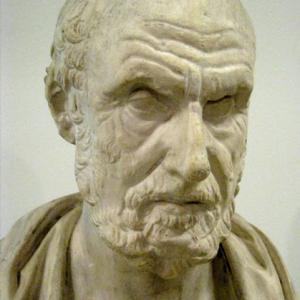
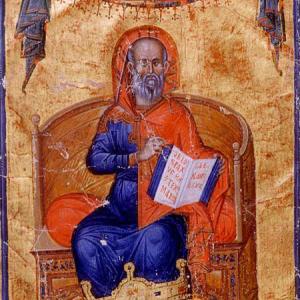
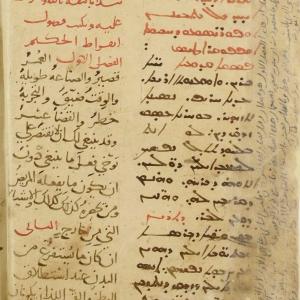
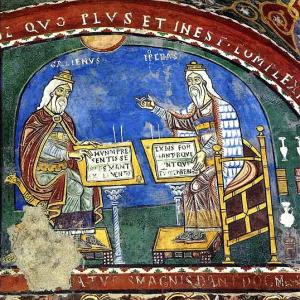
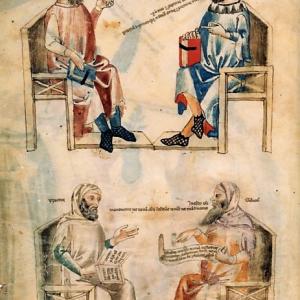
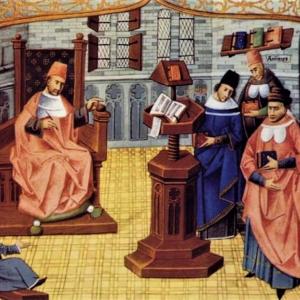
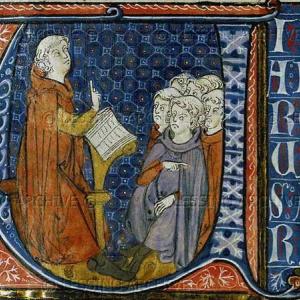
![8. Allegory of disease, in a Latin MS of Hippocrates’ 'Aphorisms', at the beginning of seventh particle (Yale, Medical Historical Library, MS 28 [Paneth Codex], f. 14v, Italy, c. 1300). 8. Allegory of disease, in a Latin MS of Hippocrates’ 'Aphorisms', at the beginning of seventh particle (Yale, Medical Historical Library, MS 28 [Paneth Codex], f. 14v, Italy, c. 1300).](/sites/default/files/styles/q_300/public/2017-11/aforismes_malaltia.jpg?h=33c5404d&itok=ER-BoXwK)
